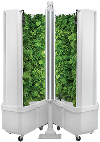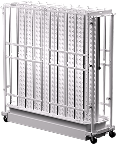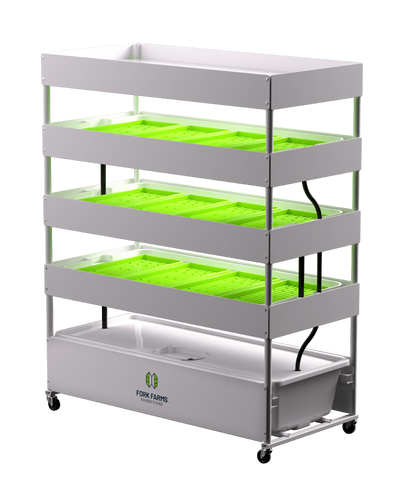The Ultimate Checklist for Buying an Indoor Hydroponics Growing System
From the impacts of climate change affecting consistent crop growth to the anticipation that Earth will need to feed another 2.3 billion people by 2050, the future of farming isn’t just coming; it’s here. With the need for long-term sustainable agriculture, organizations, communities, and individuals are investing in controlled environment agriculture (CEA) to enable consistent and predictable plant growth. This technology, which includes large and small-scale indoor hydroponic growing systems, grants a unique opportunity to find new and innovative ways to grow healthy and safe food and invest in sustainable farming.
Indoor Hydroponics Growing System: The Ultimate Checklist
Choosing a suitable indoor hydroponic growing system can be challenging, with many available options. In our experience, it’s best to focus on a system that serves your needs and goals.
First, here are a few types and product categories that grow plants and crops through:
- Deep Water Culture (DWC) – Submerging roots in a reservoir of nutrient-rich water
- Nutrient Film Technique – Covering roots with a thin layer of nutrient-rich water
- Aeroponics – Exposing the roots to air and misting them with nutrient-rich water
- Drip Systems – Controlling the flow of nutrient-rich water and slowly emitting it to roots
- Vertical Hydroponics – Feeding nutrient-rich water from the top of the vertical system
While there isn’t one correct answer for the type of system to invest in, each method has advantages and disadvantages. The best type of indoor hydroponics growing system for you will also depend on the kind of growth you hope to achieve.
There are a few styles of hydroponic systems that serve different organizations and individuals differently, including:
- DIY hydroponics – Ideal for first-time growers looking to experiment with different types of hydroponic methods and containers, such as pots and small planters
- Home hydroponic systems – Perfect for individuals all over the world who want to grow on smaller scale plants indoors year-round
- Portable indoor hydroponic systems - Ideal for organizations and schools looking to implement consistent and predictable growth through hydroponics (ex: Flex Farm system)
- Large-scale commercial system - Best for farmers and professional growers (ex: Flex Acre)
With the right approach, resources, and knowledge, these indoor hydroponics growing systems can help you grow healthy and nutritious plants and crops.
Broad Considerations
When considering an indoor hydroponics growing system, organizations should consider several factors. These broad considerations include:
- Available space - Hydroponic growing units come in various sizes and can be as compact as a tabletop unit. Our portable Flex Farm system and large-scale indoor hydroponics system, the Flex Acre, are good examples of potential sizing. For example, AeroGarden (tabletop), Lettuce Grow Farmstand (outdoor), Flex Farm (portable, indoor), and Flex Acre (large, indoor).
- Budget - Similar to size, the cost of hydroponics systems will vary. You can narrow down the fit for your needs based on your growth goals (see next bullet point).
- Required crops - How much do you need to grow? Different systems can offer various yields. The Flex Farm, for example, can produce 25+ lbs of fresh food per month, and the Flex Acre can produce 100+ lbs of fresh food per month.
- Maintenance capabilities - Every system will need maintenance, which will vary based on size and growing capacity, design of the system, exposure to outside elements, the amount of plants, required weekly upkeep, and durability of product components.
Have questions about these broad considerations? Contact us directly!
Common Questions to Ask When Considering Hydroponic Systems
As a 2023 Inc. 5000 honoree and recipient of a Wisconsin Innovation Award for product design, there are several questions we are commonly asked about indoor hydroponic growing systems. In our experience, when assessing potential companies to serve your needs, the following questions can help determine whether they best fit your needs and expectations.
- Payment Strategy: How are the payment options structured, and what financial plans are available for purchase?
- Unique Benefits and Justification: What specific advantages does this offer over comparable options, justifying its cost?
- Engagement Features: What interactive features enhance student engagement and participation?
- Budget Impact and Sustainability: What is the ongoing cost for supplies, considering individual and large-scale production metrics?
- User Proficiency and Time Commitment: Who is qualified to operate it, and what time investment is required for effective use?
- Maintenance Challenges: How are water, power, and plant management concerns addressed within settings?
- Warranty and Breakdowns: What are the warranty terms, and how are issues addressed if the product malfunctions?
- Energy Efficiency Considerations: How does the product’s power consumption align with organization-specific electric plans, especially for large-scale applications?
- Space and Infrastructure Planning: What considerations are made for space utilization, including retrofitting existing spaces or building new infrastructure for larger-scale production?
Another consideration is whether a company has additional benefits beyond growing fresh produce. For farmers, teachers, and business owners, support such as educational resources, tutorials and courses, service and support, business plans, and SOPs can be incredibly beneficial.
The Fork Farms Farmative community is an example of a potential resource. Our robust resource and knowledge base is an exclusive online community and learning environment for our customers to learn and grow from each other. Through Fork Farms’ Farmative, farmers can connect with like-minded individuals, share their experiences, and access our hydroponic knowledge base. Our knowledge base helps you get the most from your hydroponic system, ensuring implementation succeeds.
Investing in the Right Hydroponic System
To ensure that your investment serves your unique needs, aligning your organizational needs with the appropriate hydroponic system is vital. To ensure you find the best possible option, read into the advantages and disadvantages of different systems, consult with your peers, and seek our expert advice before making a choice.
By implementing a suitable hydroponic system, you can work to enhance long-term sustainability, provide several educational opportunities, and provide fresh produce cultivation for organizations.
If you are looking for a low-effort, high-impact solution that will exceed expectations, check out the Flex Farm!
Important Links:
























